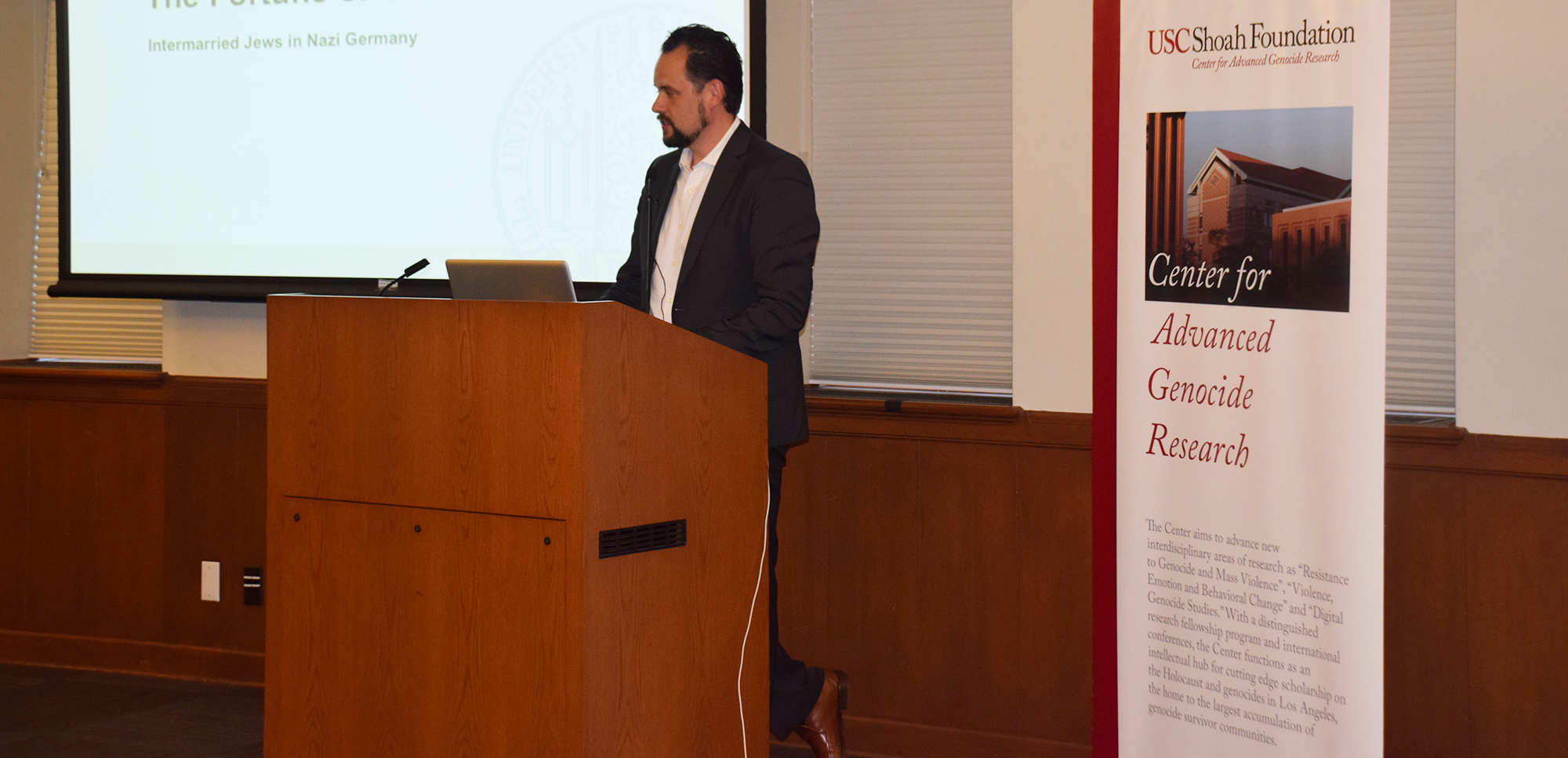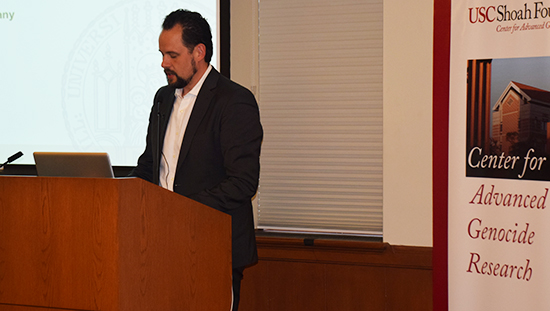Maximilian Strnad Discusses Fates of Intermarried Jews in Nazi Germany


USC Shoah Foundation Center for Advanced Genocide Research welcomed the University of Munich’s Maximilian Strnad to USC last week. Strnad gave a public lecture about the fates of intermarried Jews and their children in Nazi Germany during the Holocaust.
Strnad first outlined the complicated categories through which Nazi Germany classified who was considered “Jewish” and to what degree. Under the Nuremberg Laws, people were subject to different restrictions depending on how many Jewish grandparents they had, if they were Jewish but married to a non-Jew and vice-versa, and if they were the children of a marriage between a Jew and non-Jew, called “Mischlinge.”
Marriages between Jews and non-Jews were banned by the Nuremberg Laws in 1935, and Nazi policies were designed to encourage the remaining intermarried couples to divorce – they both could lose their jobs, which put a strain on the marriage, and non-Jews would ostracize them. Strnad highlighted the struggles of Lilli and Ernst Jahn, who were Jewish and non-Jewish, respectively. They were wealthy and well-connected in society – Ernst was a respected doctor – but once the Nuremberg Laws went into effect, Ernst’s colleagues abandoned him, and their friends and non-Jewish family turned their backs on the couple. Ultimately Ernst divorced Lilli and married a non-Jewish woman, and Lilli was murdered in Auschwitz.
Strnad pointed out, even among stigmatized intermarried couples there was a hierarchy. Families with an Aryan husband and baptized children were part of the category classified as “privileged mixed marriages”: they received better rations and the Jewish wife did not have to wear the yellow Star of David. Families with a Jewish husband and children raised Jewish, on the other hand, did not experience such favorable treatment. It was, again, a way for the government to pressure intermarried couples to divorce and convince the non-Jew to re-join the Volksgemeinschaft, or “Aryan community of blood.”
At first, intermarried couples and their children were protected from deportations and ghettoization, and Mischlinge could even join the Hitler Youth and the German army. The reason for this leniency was to avoid arousing suspicion or protest from non-Jewish family members and to encourage Mischlinge to integrate into Aryan society.
Strnad’s lecture focused on the period from 1943 to 1945 when persecution of intermarried Jews in Germany reached its climax.
As the war went on, Nazi tolerance of Mischlinge and their parents waned. With the Final Solution fully underway, Nazi officials did not want any Jews to be spared. Strnad described how in some regions, Nazis attempted to get around laws prohibiting deportation and imprisonment of intermarried Jews by saying the roundups were for “protective custody.” In several regions, this “protective custody” resulted in the deaths of intermarried Jews in Auschwitz, at a time when they were officially exempt from deportation.
Beginning in 1944, a large number of intermarried Jews were put into segregated labor battalions of the Todt Organization (OT) and others sent to Theresienstadt, labor camps, and ghettos.
By January 1945, the war was in its final months, and the Third Reich was losing. The Reich Security Main Office lifted its protection for intermarried Jews and ordered all remaining Jews deported. However, the success of these deportations and the number of Jews deported varied widely by region. In some cities, only a handful of intermarried Jews and Mischlinge were deported while other cities deported the majority of the remaining Jews. Some local authorities granted exemptions from deportation while others did not. Some regions’ infrastructures were too damaged by war to organize transports while other regions could still operate efficiently. People’s fates depended largely on the local circumstances of each city and region and the methods employed by the Nazis in charge to identify and round up the remaining Jews.
Of the approximately 15,000 Jews liberated in Germany proper after the war, about 10,000 had a non-Jewish spouse. But Strnad said that no one factor, such as having an Aryan spouse or being non-Jewish by faith, guaranteed survival for an intermarried Jew.
“Their fate remained negotiable till the very end,” Strnad said.
Even after the war, their survival was tenuous, Strnad added. Though they had also lost their homes, jobs, educations and livelihoods, intermarried Jews from the Nazi category of “privileged mixed marriages” often received lower food rations and other aid because they were perceived to not have suffered as much as other Jews had, such as being forced to wear the yellow star or live in a ghetto or concentration camp. In the years after the war, they continued to struggle to rebuild their lives.
Maximilian Strnad is a PhD candidate at the University of Munich, where he received his MA in 2007. Until 2013 he served as a research assistant first at the University of Munich and at the NS-Documentation Center in Munich. He is currently a Sosland Family Foundation Fellow at the Jack, Joseph and Morton Mandel Center for Advanced Holocaust Studies, United States Holocaust Memorial Museum, Washington D.C. Among his recent publications are: "The Fortune of Survival - Intermarried German Jews in the late stage of the Shoah" (Dapim 2015); Flachs für das Reich. Das jüdische Zwangsarbeitslager 'Flachsröste Lohhof' bei München
Like this article? Get our e-newsletter.
Be the first to learn about new articles and personal stories like the one you've just read.